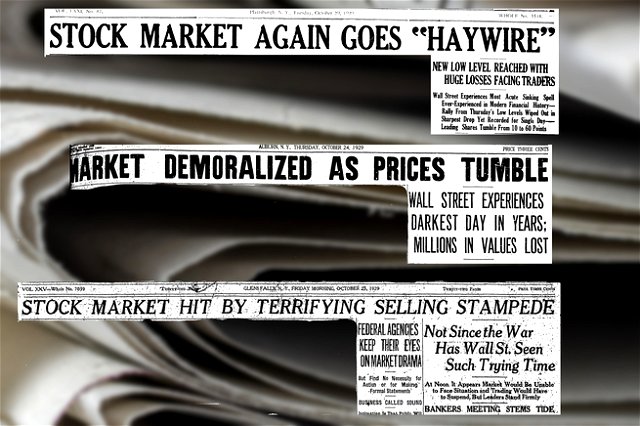Black Tuesday was a significant moment in financial history that occurred on October 29, 1929. It was the day the stock markets suffered a significant crash of 12%. It also marked the beginning of the period known as The Great Depression, a time of poverty, homelessness, mass unemployment, and cautious spending.
The Wall Street Crash
The Wall Street Crash was a massive stock market crash in September and October 1929. During the whole crash, the Dow Jones lost 30% of its value making it one of the most disastrous declines in US financial history.
There are a few notable dates associated with The Wall Street Crash. As well as Black Tuesday, there was Black Thursday on October 24, and Black Monday on October 28.

Background
Prosperity
The crash marked the end of a time of prosperity in America. The 1920s has the moniker The Jazz Age, and The Roaring Twenties, and it was a time of wealth creation and excess.
For the younger generations, it was a time of celebration at seeing the end of World War One, and a lifestyle of enjoying life and its pleasures. This included being able to afford more luxury products such as vehicles and property.
It was a good time to be an American. There was massive growth in the economy during the 1920s to keep up with the demands of this new generation of consumers.
Demand
To keep up with the demand for more luxury goods and a modern lifestyle a new culture of loans and credit expanded, this culture however became harder for banks and companies to keep up with. People took the money they had saved up in bank accounts and began taking risks purchasing bonds and investing in stocks that promised high returns. During this time loan sharks became more popular, providing finances to people who spent beyond their means.
Panic
As stock prices began to decline in September and October 1929, people started to panic as they saw their investments lose value. During Black Monday and Black Tuesday, the market lost 25% of its entire value, equaling more than $30 billion, and those with loans suddenly found themselves unable to keep up with repayments.
One common belief was that there were many suicides during this time and that bankers were jumping out of the windows out of desperation. This is actually false, there were no more deaths than usual for that time of the year.
A slow recovery
Over the following years, the government attempted several measures in order to bring stability back to the stock market, and some of them provided small rebounds. For example, the president at the time, Herbert Hoover, increased taxes on nearly one thousand different imports as well as income tax on the highest earners. Those measures however did not stop the trend of increasing unemployment and bank closures, with banks such as The Bank of the United States and The Bank of Tennessee failing.
Franklin D Roosevelt became president in 1933 and he also brought in policies to combat The Great Depression, including The New Deal, a collection of policies and acts designed to stabilize the economy. Such policies included bank holidays in order to prevent bank runs and outlaw the private ownership of gold. With these and many other measures in place, the economy started to improve, however, it was not until the Second World War in 1939 that the market began to fully recover from the collapse.











